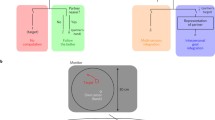Abstract
Humans have a natural ability to haptically interact with other humans, for instance while physically assisting a child to learn how to ride a bicycle. A recent study has shown that haptic human-human interaction can improve individual motor performance and motor learning rate while learning to track a continuously moving target with a visuomotor rotation. In this work we investigated whether these benefits of haptic interaction on motor learning generalize to a task in which the interacting partners track a target while they learn novel dynamics, represented by a force field. Pairs performed the tracking task and were intermittently connected to each other through a virtual spring. Motor learning was assessed by comparing each partner’s individual performance during trials in which they were not connected to the performance of participants who learned the task alone. We found that haptic interaction through a compliant spring does not lead to improved individual motor performance or an increase in motor learning rate. Performance during interaction was significantly better than when the partners were not interacting, even when connected to a worse partner.
Access this chapter
Tax calculation will be finalised at checkout
Purchases are for personal use only
Similar content being viewed by others
References
Aglioti, S.M., Cesari, P., Romani, M., Urgesi, C.: Action anticipation and motor resonance in elite basketball players. Nat. Neurosci. 11(9), 1109–1116 (2008)
Avila Mireles, E.J., Zenzeri, J., Squeri, V., Morasso, P., De Santis, D.: Skill learning and skill transfer mediated by cooperative haptic interaction. IEEE Trans. Neural Syst. Rehabil. Eng. 25(7), 832–843 (2017)
Baur, K., Wolf, P., Riener, R., Duarte, J.E.: Making neurorehabilitation fun: multiplayer training via damping forces balancing differences in skill levels. In: 2017 International Conference on Rehabilitation Robotics (ICORR), pp. 876–881. IEEE (2017)
Beerens, G.C., Damveld, H.J., Mulder, M., van Paassen, M.M., Van Der Vaart, J.C.: Investigation into crossover regression in compensatory manual tracking tasks. J. Guid. Control Dyn. 32(5), 1429–1445 (2009)
Conditt, M.A., Gandolfo, F.: The motor system does not learn the dynamics of the arm by rote memorization of past experience. J. Neurophysiol. 78(1), 554–560 (1997)
Ganesh, G., Takagi, A., Osu, R., Yoshioka, T., Kawato, M.: Two is better than one: physical interactions improve motor performance in humans. Sci. Rep. 4, 3824 (2014)
Granados, C., Wulf, G.: Enhancing motor learning through dyad practice: contributions of observation and dialogue. Res. Q. Exerc. Sport 78(3), 197–203 (2007)
Mace, M., Kinany, N., Rinne, P., Rayner, A., Bentley, P., Burdet, E.: Balancing the playing field: collaborative gaming for physical training. J. NeuroEng. Rehabil. 14(1), 1 (2017)
Mattar, A.G., Gribble, P.L.: Motor learning by observing. Neuron 46(1), 153–160 (2005)
Reed, K.B., Peshkin, M.A.: Physical collaboration of human-human and human-robot teams. IEEE Trans. Haptics 1(2), 108–120 (2008)
Sawers, A., Bhattacharjee, T., McKay, J.L., Hackney, M.E., Kemp, C.C., Ting, L.H.: Small forces that differ with prior motor experience can communicate movement goals during human-human physical interaction. J. NeuroEng. Rehabil. 14(1), 8 (2017)
Sawers, A., Ting, L.H.: Perspectives on human-human sensorimotor interactions for the design of rehabilitation robots. J. NeuroEng. Rehabil. 11(1), 142 (2014)
Sebanz, N., Bekkering, H., Knoblich, G.: Joint action: bodies and minds moving together. Trends Cogn. Sci. 10(2), 70–76 (2006)
Shadmehr, R., Mussa-Ivaldi, F.A.: Adaptive representation of dynamics during learning of a motor task. J. Neurosci. 14(5), 3208–3224 (1994)
Takagi, A., Beckers, N., Burdet, E.: Motion plan changes predictably in dyadic reaching. PLoS ONE 11(12), e0167314 (2016)
Takagi, A., Ganesh, G., Yoshioka, T., Kawato, M., Burdet, E.: Physically interacting individuals estimate the partner’s goal to enhance their movements. Nature Hum. Behav. 1(3), 0054 (2017)
Tong, C., Flanagan, J.R.: Task-specific internal models for kinematic transformations. J. Neurophysiol. 90(2), 578–585 (2003)
Wulf, G., Shea, C.H.: Principles derived from the study of simple skills do not generalize to complex skill learning. Psychon. Bull. Rev. 9(2), 185–211 (2002)
Author information
Authors and Affiliations
Corresponding author
Editor information
Editors and Affiliations
Rights and permissions
Copyright information
© 2018 Springer International Publishing AG, part of Springer Nature
About this paper
Cite this paper
Beckers, N., Keemink, A., van Asseldonk, E., van der Kooij, H. (2018). Haptic Human-Human Interaction Through a Compliant Connection Does Not Improve Motor Learning in a Force Field. In: Prattichizzo, D., Shinoda, H., Tan, H., Ruffaldi, E., Frisoli, A. (eds) Haptics: Science, Technology, and Applications. EuroHaptics 2018. Lecture Notes in Computer Science(), vol 10893. Springer, Cham. https://doi.org/10.1007/978-3-319-93445-7_29
Download citation
DOI: https://doi.org/10.1007/978-3-319-93445-7_29
Published:
Publisher Name: Springer, Cham
Print ISBN: 978-3-319-93444-0
Online ISBN: 978-3-319-93445-7
eBook Packages: Computer ScienceComputer Science (R0)




